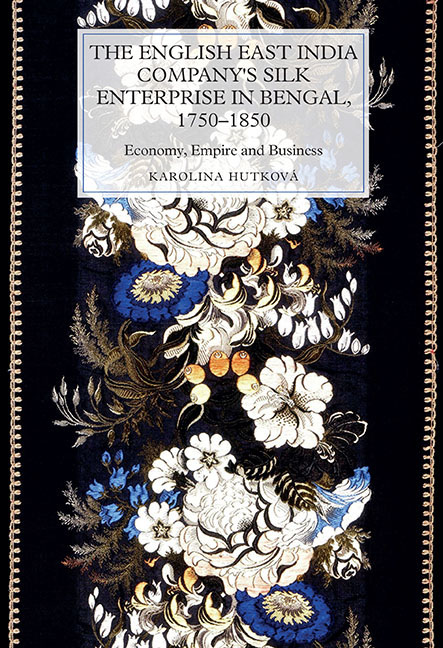Book contents
- Frontmatter
- Contents
- List of Illustrations
- Acknowledgements
- List of Abbreviations
- Measures and Currencies
- Introduction: Companies, Political Economy and the Great Divergenc
- Chapter 1 The Early Modern Silk Industry, Trade and Mercantilism
- Chapter 2 Empire, the English East India Company, and Bengal Raw Silk
- Chapter 3 Bengal, Piedmont and the English East India Company
- Chapter 4 The Bengal Silk Industry and the English East India Company
- Chapter 5 Filatures and Performance in the Bengal Silk Industry
- Chapter 6 The Bengal Silk Industry and British Laissez-Faire Policies
- Chapter 7 Bengal Raw Silk and British Demand in the Nineteenth Century
- Conclusion
- Appendix A Description of the Piedmontese Reeling Machine by Dionysius Lardner
- Appendix B Average Prices of Bengal Raw Silk on the British Market According to the Type of the Silk, 1796–1856
- Appendix C Return on Investment Analysis
- Appendix D Comparison of Manufacturing Costs at the EEIC's Experimental Filature and Common Filature in its Vicinity, 1832
- Appendix E Mechanisation of Silk Throwing and Weaving in England and Scotland, 1856
- Appendix F Types of Silkworm Reared in Bengal Silk Districts, 1818
- Appendix G Glossary
- Bibliography
- Index
- WORLDS OF THE EAST INDIA COMPANY
Chapter 1 - The Early Modern Silk Industry, Trade and Mercantilism
Published online by Cambridge University Press: 31 August 2019
- Frontmatter
- Contents
- List of Illustrations
- Acknowledgements
- List of Abbreviations
- Measures and Currencies
- Introduction: Companies, Political Economy and the Great Divergenc
- Chapter 1 The Early Modern Silk Industry, Trade and Mercantilism
- Chapter 2 Empire, the English East India Company, and Bengal Raw Silk
- Chapter 3 Bengal, Piedmont and the English East India Company
- Chapter 4 The Bengal Silk Industry and the English East India Company
- Chapter 5 Filatures and Performance in the Bengal Silk Industry
- Chapter 6 The Bengal Silk Industry and British Laissez-Faire Policies
- Chapter 7 Bengal Raw Silk and British Demand in the Nineteenth Century
- Conclusion
- Appendix A Description of the Piedmontese Reeling Machine by Dionysius Lardner
- Appendix B Average Prices of Bengal Raw Silk on the British Market According to the Type of the Silk, 1796–1856
- Appendix C Return on Investment Analysis
- Appendix D Comparison of Manufacturing Costs at the EEIC's Experimental Filature and Common Filature in its Vicinity, 1832
- Appendix E Mechanisation of Silk Throwing and Weaving in England and Scotland, 1856
- Appendix F Types of Silkworm Reared in Bengal Silk Districts, 1818
- Appendix G Glossary
- Bibliography
- Index
- WORLDS OF THE EAST INDIA COMPANY
Summary
Silk has long been considered the queen of fabrics and has been associated with luxury consumption. It never achieved a high share of the global fibre market and yet the economic, social and cultural role of silk in premodern societies far outweighed its quantitative importance. As a labour-intensive industry, silk manufacturing produced goods of high value and brought revenues through taxation. Domestic production of silk prevented the outflow of bullion – something abhorred by mercantilists. Due to its high value and low volume, silk became one of the first globally traded commodities. Thanks to its potential for employing the poor, silk was also considered a strategic industry in the early modern period.
Scholarship has asserted the role of the silk industry in fostering economic development in the early modern and modern periods. The contribution of the silk industry to development was, however, reliant on the adoption of up-todate technologies. Technology leadership in the early modern silk industry was achieved by China, Italy and France. In Europe, adoption of new technologies in the silk industry was endorsed by governments through support for migration of those persons skilled in silk production, tariff protection of domestic silk production, preferential tariffs on raw silk imports, and endorsement of industrial espionage. Such economic policies had their grounding in the mercantilism of the early modern period. The nineteenth-century rise of classical economics and the implementation of laissez-faire policies led to the disbanding of the measures protecting the silk industry in Europe. This in turn led to the decline and restructuring of the less competitive silk industries such as that in Britain. Similarly, as in other industries, the nineteenth century brought innovations in silk technologies and organisation, and the shift of technology leadership to Europe. In the late nineteenth century, great progress was achieved by the Japanese silk industry which successfully adopted and adapted European silk technologies, supported by the Meiji government and entrepreneurs.
Development of the Bengal silk industry was strongly influenced by the British political economy and its connection to the British silk industry. Studying it only with reference to Britain, however, would be inconclusive as the industry was also shaped by global trends in silk production and consumption. To consider the Bengal silk industry from a broader perspective, this chapter first summarises the stages of silk production.
- Type
- Chapter
- Information
- The English East India Company's Silk Enterprise in Bengal, 1750–1850Economy, Empire and Business, pp. 17 - 40Publisher: Boydell & BrewerPrint publication year: 2019

